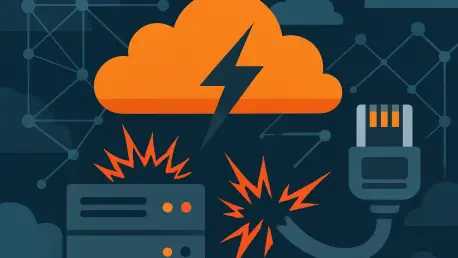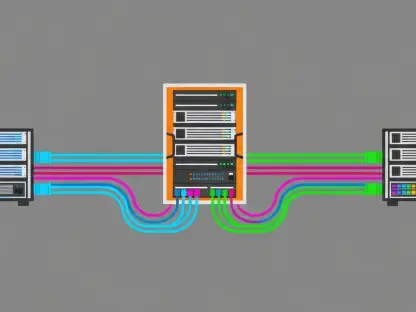On a seemingly ordinary day, November 18, a staggering six-hour outage struck Cloudflare, a cornerstone of internet infrastructure, disrupting services for millions of users worldwide, including major platforms like ChatGPT, Canva, and segments of Amazon Web Services (AWS). This incident wasn’t triggered by a malicious cyberattack but by a minor internal change—a database permission tweak in the Bot Management system—that spiraled into a global network failure. Such an event raises a pressing concern: how can a small misstep in configuration wreak havoc on a scale that halts critical digital services? This research summary explores the intricate details of this outage, shedding light on the vulnerabilities of modern cloud systems and the urgent need for resilience in an era where internet stability is paramount.
The significance of this disruption extends beyond immediate inconvenience, touching on the very foundation of today’s digital economy. As a leading content delivery network (CDN) and security provider, Cloudflare supports countless businesses and users who depend on seamless connectivity. The outage serves as a stark reminder of the fragility embedded in complex, interconnected systems, prompting a deeper investigation into how internal errors are becoming the dominant threat to internet reliability, surpassing even external attacks like DDoS. This analysis aims to unpack the root causes, systemic implications, and necessary safeguards to prevent future catastrophes.
Unpacking the Cloudflare Outage: A Critical Incident Overview
The Cloudflare outage on November 18 exposed the fragility of global internet infrastructure, with its six-hour duration affecting a vast array of services. High-profile platforms, from ChatGPT to Canva and parts of AWS, experienced significant downtime, impacting millions of users and businesses. This wasn’t a localized glitch but a widespread failure that disrupted core internet traffic processing, revealing the extensive reach of Cloudflare’s network.
At the heart of this incident was a seemingly innocuous database permission change within the Bot Management system. This minor adjustment triggered a cascading effect, ultimately crippling the global network and leading to HTTP 5xx errors across services. The scale of disruption was compounded by the impact on dependent functionalities like Workers KV, illustrating the deep interdependencies within Cloudflare’s architecture.
Key questions arise from this event: How could such a small change lead to widespread chaos? What does this reveal about the vulnerabilities in modern internet infrastructure? These inquiries point to a broader issue of systemic risk in cloud environments, where even routine updates can become catastrophic without rigorous safeguards, setting the stage for a detailed examination of the incident’s causes and consequences.
Background and Context: The Growing Risk of Internal Errors
Cloudflare stands as a pivotal player in the digital realm, serving as a major CDN and infrastructure provider that accelerates and secures internet traffic for countless websites and applications. Its role in mitigating external threats like DDoS attacks has been well-documented, yet the November 18 outage highlights a shift in the nature of risks facing such providers. Internal operational errors are increasingly overshadowing external threats as the primary cause of disruptions in cloud systems.
This trend is not unique to Cloudflare; similar incidents have plagued other industry giants. For instance, Microsoft Azure faced a global outage due to a tenant configuration misstep in its Front Door service, while AWS encountered issues stemming from a defect in DNS management. These examples underscore a critical shift: as cloud systems grow in complexity and deployment cycles accelerate, the likelihood of self-inflicted errors during updates rises, posing new challenges to stability.
The broader relevance of this issue lies in the intricate nature of today’s digital ecosystem. Rapid innovation and the push for continuous updates often outpace the maturity of validation processes, leaving systems vulnerable to unintended consequences. This context emphasizes the urgent need for robust mechanisms to manage changes in highly interconnected environments, a theme central to understanding the Cloudflare outage and its implications for the industry.
Research Methodology, Findings, and Implications
Methodology
To dissect the Cloudflare outage, a comprehensive approach was adopted, drawing from multiple sources to ensure a thorough understanding of the incident. Analysis began with a detailed review of Cloudflare’s official incident report, which provided critical insights into the timeline and technical specifics of the failure. This was supplemented by expert commentary from industry analysts such as Sanchit Vir Gogia of Greyhound Research and Pareekh Jain of Pareekh Consulting, whose perspectives added depth to the interpretation of the event.
Further, comparative data from similar outages at other major providers like Microsoft Azure and AWS were examined to contextualize the incident within industry-wide patterns. Tools and techniques such as system log analysis, update propagation timelines, and dependency mapping within Cloudflare’s multi-layered architecture were employed to trace the failure’s progression. This methodology aimed to construct a clear picture of how a minor change escalated into a global disruption, ensuring a robust foundation for the findings.
Findings
The root cause of the outage was traced to a database permission change in the ClickHouse cluster, part of Cloudflare’s infrastructure. This alteration inadvertently generated duplicate entries in the Bot Management feature file, causing its size to double and exceed system limits. As this file is updated every five minutes and distributed across the global network, the error quickly propagated, overwhelming the Bot Management module integral to core traffic processing.
This triggered a cascading failure, manifesting as HTTP 5xx errors that disrupted not only primary traffic handling but also dependent services like Workers KV and Access. Initially, the issue was misdiagnosed as a DDoS attack due to fluctuating error codes, delaying identification of the true cause. Resolution was eventually achieved by halting the propagation of the corrupted file and reverting to a stable version, alongside restarting core proxy systems to restore normalcy.
The findings highlight the fragility of interconnected systems, where a single point of failure in a critical module can paralyze an entire network. The integration of dynamic, AI-driven components like Bot Management into essential pipelines amplified the impact, exposing design vulnerabilities that allowed a routine update to escalate into a global issue. These insights provide a critical lens for understanding the incident’s broader significance.
Implications
From a practical standpoint, this incident underscores that even minor changes in complex systems can precipitate massive disruptions, necessitating meticulous update management and validation protocols. Organizations must prioritize rigorous testing before deployment to prevent similar failures, as the cost of downtime extends beyond technical issues to significant business and user impact. This takeaway is vital for cloud providers aiming to maintain service reliability.
Theoretically, the outage reveals the heightened risk of incorporating AI-driven modules into critical request pipelines without adequate safeguards. Such integrations, while innovative, can become liabilities if not isolated from core functions or supported by robust error-handling mechanisms. This perspective calls for a reevaluation of how emerging technologies are embedded within essential infrastructure, balancing innovation with stability.
On a societal level, the disruption affected millions, highlighting the importance of resilient internet infrastructure for economic and social stability. Businesses reliant on Cloudflare’s services faced operational setbacks, while end users experienced interrupted access to essential tools. This broader impact emphasizes that internet reliability is not merely a technical concern but a foundational element of modern life, urging stakeholders to address systemic vulnerabilities proactively.
Reflection and Future Directions
Reflection
Analyzing the Cloudflare outage revealed significant challenges in grasping the full scope of interdependencies within its intricate, multi-layered architecture. Mapping how a single database change affected disparate components across a global network proved complex, as the interactions between modules like Bot Management and core proxy systems were not immediately apparent. This complexity underscores the difficulty of predicting failure points in such environments.
Another observation was the initial bias toward suspecting an external attack, such as a DDoS assault, which delayed pinpointing the internal misconfiguration. This mirrors a broader industry tendency to focus on outside threats over operational errors, often skewing early response efforts. Such assumptions can hinder swift resolution, suggesting a need for diagnostic approaches that equally consider internal causes from the outset.
Areas warranting deeper investigation include the specifics of automated deployment pipelines and their validation shortcomings. Understanding how updates are tested and propagated in real-time could uncover critical gaps in current practices. Additionally, exploring the design decisions behind integrating high-risk modules into core systems might reveal opportunities for mitigating similar risks in the future.
Future Directions
Research into advanced dependency mapping and failure simulation tools holds promise for predicting the impact of minor changes in complex systems. Developing frameworks that model potential failure cascades before updates are deployed could help identify vulnerabilities preemptively. Such tools would enable providers to anticipate and address risks, enhancing overall system robustness.
Exploring design strategies like isolating critical functions from optional modules, implementing graceful degradation modes, and adopting multi-provider architectures offers pathways to greater resilience. Isolation could prevent a single failure from affecting the entire network, while degradation modes would allow systems to function at reduced capacity during issues. Multi-provider setups, though resource-intensive, could reduce dependency on a single intermediary for critical operations.
Unanswered questions persist, such as how the industry can balance rapid innovation with thorough testing. Additionally, what systemic changes are required to prevent recurring outages of this nature? Addressing these challenges will likely involve collaborative efforts across providers, researchers, and policymakers to redefine best practices for update management and system design in an increasingly complex digital landscape.
Lessons Learned and the Path Forward
The Cloudflare outage stands as a revealing case study on the fragility of modern internet infrastructure when faced with internal misconfigurations. It demonstrates that operational errors have now eclipsed external threats as the leading cause of major disruptions, a shift that demands urgent attention from the industry. The incident’s scale, affecting global services for hours, amplifies the stakes involved in maintaining digital stability.
These findings reinforce the critical need for enhanced update validation and system resilience. Cloud providers must move beyond reactive fixes to embrace strategic designs that mitigate the impact of failures. The integration of AI-driven components, while innovative, requires careful management to avoid introducing new vulnerabilities into essential pipelines, a lesson that extends across the sector.
Looking ahead, the incident served as a call to action for implementing actionable solutions like global kill switches, stricter configuration validation, and isolated architectures. Cloud providers and enterprises were urged to collaborate on developing simulation tools to stress-test updates, ensuring minor changes do not escalate into crises. By prioritizing resilience and investing in systemic safeguards over the following years, the industry took steps to fortify internet infrastructure against the evolving challenges of complexity and scale, aiming to protect the digital ecosystem that underpins modern society.









